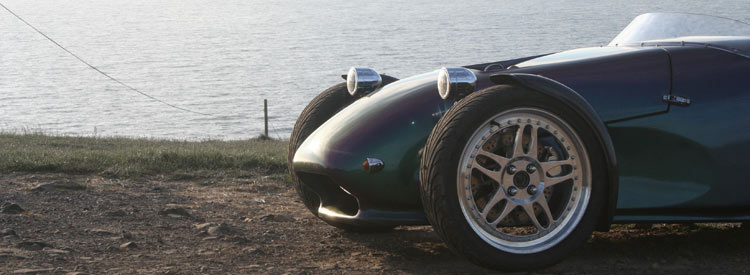


![]()
FIRST impressions. They can be a powerful influence on your future opinions about a car - love at first sight can take you 'straight to cheque book', without a passing glance towards logic or reason. Or they can play a big part in creating an unfounded prejudice toward a product.
Right, this is where I put my hands up, and say that in the case of the Malone Skunk I was initially way off kilter. When I first saw the car at Stoneleigh last year, I gauged the size of the company, looked at finish of the prototype, and concluded that it was a well meaning attempt by a nice family that would not actually work in practice.
In fact, the reality is quite different. The Skunk features a lot of very neat design touches that set it aside from the competition, and create a nice little niche for it.
Those first impressions would have you immediately peg the Skunk as a cheaper rival for the Grinnall Scorpion, because it is a modern interpretation of a three-wheeler, rather than one of the traditionally styled Morgan-type replicas that dominate this market. But having driven both within the space of a week, I can state that they are very different in character, and approaches to the same problems.
The first is a fundamental one. Imagine a triangle between the three wheels. The ideal is to keep all the weight between those wheels, and as low as possible. As you can read else-where (see page 64) in Adrian Harris's technical analysis of the subject, three wheelers suffer a bad stability image because the Reliant Robin tries to balance a heavy engine block virtually on top of the single wheel, high up in the frame. The equivalent of a unicycle rider carrying another guy on his shoulders. He ain't gonna win no cycle race!
Grinnall mount the engine immediately behind the passengers, who in turn are pushed forward. The Skunk puts the engine transversely between the front wheels, with a shaft between the passengers to take drive to the rear. Achieving the same result in principle, but leading to a cab forward design for the Scorpion, and a more traditional position for the Skunk.
All this is held together by a fully triangulated spaceframe, with double wishbones up front, operating through a rising rate spring linkage, and swing arms out back. The front tyres are 195.50x15s upfront with a 150.60x17 out back - all run-flat tyres, with tyre pressure sensors.
I must admit I didn't fully exploit the Skunk's chassis - partly because it is very, very good, and you'd have to be somewhere between talented and stupid to really push it to the limits, but also because my feet are very, very big, and there simply wasn't room for any fancy footwork. Jon Malone assured me that there is room to tailor the pedal arrangement to suit even gorillas like me!
With a dry weight short of 300kg, the 105bhp Yamaha lump really does make the Skunk... well, go like stink (you didn't think I could resist that for long did you?). And this 900cc lump does give the added bonus of 30-50 mpg, depending on whether you're caning it or not. You can go up to 1127cc, and units from Suzuki and Kawasaki can also be used.
I thought I did pretty well at first. I cracked the right amount of revs to pull away, snicked the clever paddle shift back into first, and we were away, with a brave Jon Malone beside me. Trying not to catch the brake with either my throttle or clutch foot took a few yards to master, but if I can drive the Skunk with my huge feet, anyone can! The prototype is set up pretty soft in order to deal with the rutted roads around the company base, and Jon told me that once onto a fast A-road you merely dial up the adjustable dampers a click and it is transformed!
Having said that, and I may sound like an old git, I liked the soft set-up. The wheels stayed in contact with the road far better through a bumpy corner and, I thought, actually get more grip. I recently drove the new TVR Tuscan, which is set up softer than previous models, and not only does it feel more sophisticated than say, the Griffith, but handles much better too. Having failed to find the outer limits, Jon and I swapped places, and with the aid of familiarity, and local knowledge, he proceeded to drive much faster than I dared, but still it was clear the rear-end would not be unstuck. He later explained that, perversely, once the Skunk starts to drift, he plants his foot down harder, and the beasty finds some extra reserves from somewhere and pulls itself through. We're in the realms of serious nutter territories here, though, so if any of you are harbouring thoughts of reaching these limits, please do it on a track - and well away from me!
Back at base we were greeted by a delightful example, built over five months by a customer. Finished in bright yellow, with an engine-turned dash and tastefully executed cockpit, it really did reflect as a credit to the owner's skill as a builder. He reckons he spent somewhere around £7,000 putting his Skunk on the road, which has to be a bargain. It sports the same Yamaha 900cc lump as
the demonstrator, and externally differs most in having traditional seven-inch headlamps, rather than the twin affair of the company car. £7000 is definitely not a lot to spend on a car that puts so big a smile on your face. Personally, the only thing that has put me off going for a motorcycle license is that I've managed to knacker my knees even without having fallen off one (probably trying to control those enormous feet - MF). The Skunk gave me a taste of what I'm missing, from the sounds to the incredible performance. If you're thinking along similar lines, your answer resides in Devon. And you won't find nicer people to deal with than the Malone Family!